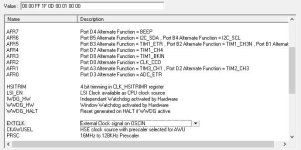Regarding the issues with Cute/Q motors:
Translation from this page, for the Lishui LSW-675 using the STM32F103: http://www.groetech.de/index.php?main_page=product_info&products_id=452
Note: The motor speed for sinusoidal controllers is slightly slower than otherwise with normal square wave controllers. The controller does not work properly with high gear ratio (gear ratio over 10) motors like some "cute motors".
Still, there are some reports saying the Q75 motor can't run well with S06P but can run well with LSW-675. Q75 don't have hall sensors and so needs S06P which is different from S06S, as S06P is not sine wave.
Cute/Q85 motors
Reduction ratio: 12.6
Rotor alnico magnets number: 16
328RPM version
• rotor RPM = 328 * 12.6 ~= 4133 RPM
◇ eRPM = 4133 * (16 / 2) =
33056 eRPM
Cute/Q75 motors
reduction ratio: 13.4
rotor alnico magnets number: 16
328RPM version
• rotor RPM = 328 * 13.4 ~= 4400RPM
◇ eRPM = 4400 * (16 / 2) =
35200 eRPM
---------------------------------
http://www.microchip.com/forums/m619210.aspx#619979
I'm building a driver board to work with Field Oriented Control on the dsPIC33FJ12MC202.
Starting from AN1078, I'm a little unclear from reading the App Note and Tuning Guide- what is actual the limit on how fast the motor can be driven?
consider the following timings: -
FOC calculation takes 22uSec. This time also includes the execution time of "estimator" for back emf. The back emf is reflection of the speed of the motor. For a good sinusoidal back emf to be estimated, the estimator should run some 80 samples. Thats an assumption and might vary a little bit.
So, for a good back emf waveform, the sine wave should have 80 samples. So, 80 * 22usec = 1760uSec = 568Hz.
Hence, you can consider that 568Hz (aprox) is the highest electrical speed you can achieve.
If your motor is 4 pole, max mechanical speed = (120 * 568)/4 = 17,000RPM
If your motor is 8 pole, max mechanical speed = (120 * 568)/8 = 8,500RPM
Oznog
I'm looking at different motors too, for different apps. Some would need to go into the range of 20,000 RPM.
For high speed drives, FOC might not be the best option. Try sensorles back emf based drives. Those needs lesser execution and hence can run motor at higher speeds. Try AN1160.
For extremely high speeds, we might want to do away with any executions. That will need external comparator to detect the zero crossing of back emf.
---------------------------------
http://kellycontroller.com/faqs.php
What's BLDC high speed model and ultra high speed model differ from standard model?
32-bit microprocessor, higher PWM frequency.
Standard model: 16.6KHz, 40,000 eRPM.
High speed model: 33KHz, 70,000 eRPM.
Ultra high speed model: 100KHz, 100,000 eRPM.
eRPM=Mechanical RPM*Pole pairs.
It does generate more heat because of higher switching frequency.
When will High speed motor option or Ultra high speed motor option be necessary for the motor?
Please note high speed motor option is only useful for high speed motor.
eRPM=RPM*Pole Pairs.
The standard controller can support 40,000eRPM.
What is the criterion for high speed motor?
When eRPM of the motor is above 40,000, we can call it high speed motor for Kelly controller.
The high speed motor option doesn't mean it will push the motor to get a higher speed.
High speed motor option means that it is capable of catching the hall switching time of high speed motor.
If the motor is 40,000eRPM below, the standard controller can tackle the switching signal from hall sensor.
The motor will run properly.
That is why we don't add high speed motor option to the controller for low speed motor, which is not used to increase RPM.
The speed is the inherent characteristic of the motor. We can not change it.
Just like resistance is the inherent characteristic of the resistor.
Similarly Ultra high speed motor option is only useful for ultra high speed motor(70KeRPM-100KeRPM).



